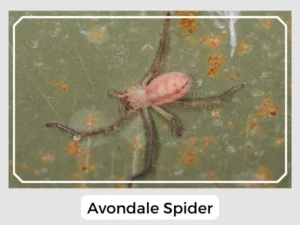The Avondale spider comes from the huntsman spider family. It got its name from a place called Avondale in Auckland. Some people also call it the social huntsman or flat huntsman spider. These spiders mostly live in Australia.
Female Avondale spiders produce flat and oval egg sacs and subsequently lay around 200 eggs in them. Few spiders even make a silken base for the sac just before the egg-laying process and once all eggs are released, they carry the sac and discard the silken base. The egg sac is often carried by mother spiders.
Young Avondale spiders come out of the eggs with a pale complexion. Sometimes, the mother spider moistens the egg sac and then tears it open to make the emergence of young spiders smooth and hassle-free. After coming out of the eggs, the spiderlings stay a few weeks with their mothers.
This species of spider does not make any webs as it directly hunts down insects.
Yes, Avondale spiders have venom. But it’s mainly used to catch their food. It’s not very strong for humans.
They can bite if they’re disturbed. The bite might be a little pinchy or itchy, but most people don’t think it’s too bad.
The Avondale spider plays a crucial role in controlling insect populations, aiding in the ecological balance of its habitat. Its hunting behavior is a spectacle of agility and precision, as it swiftly captures its prey. This nocturnal hunter is a vital player in the complex web of life, contributing to biodiversity and the health of its ecosystem.
Natural Predators: In the natural world, the Avondale spider is not without threats. Birds and larger insects pose as predators, creating a delicate balance in the predator-prey dynamics.
Prey-Predator Dynamics: This interaction underscores the spider’s agility and adaptability, traits that are vital for survival.
Relationship with Humans: Despite their portrayal in films and media, Avondale spiders are largely harmless to humans. Their presence around homes can actually be beneficial, as they help in controlling pest populations. Understanding and respecting this spider’s role in nature can lead to a harmonious coexistence, fostering an appreciation for these remarkable creatures.
| Other Names | Social huntsman spider, flat huntsman spider |
| Distribution | Australia and New Zealand |
| Habitat | Barks, logs, and rocks |
| Diet | Insects |
| Lifespan | Around 2 Years |
| IUCN Conservation Status | Not listed |

In summary, the Avondale spider, with its fascinating behavior, significant ecological role, and unique characteristics, stands as a captivating subject in the world of arachnology.
The Avondale spider comes from the huntsman spider family. It got its name from a place called Avondale in Auckland. Some people also call it the social huntsman or flat huntsman spider. These spiders mostly live in Australia.
Female Avondale spiders produce flat and oval egg sacs and subsequently lay around 200 eggs in them. Few spiders even make a silken base for the sac just before the egg-laying process and once all eggs are released, they carry the sac and discard the silken base. The egg sac is often carried by mother spiders.
Young Avondale spiders come out of the eggs with a pale complexion. Sometimes, the mother spider moistens the egg sac and then tears it open to make the emergence of young spiders smooth and hassle-free. After coming out of the eggs, the spiderlings stay a few weeks with their mothers.
This species of spider does not make any webs as it directly hunts down insects.
Yes, Avondale spiders have venom. But it’s mainly used to catch their food. It’s not very strong for humans.
They can bite if they’re disturbed. The bite might be a little pinchy or itchy, but most people don’t think it’s too bad.
The Avondale spider plays a crucial role in controlling insect populations, aiding in the ecological balance of its habitat. Its hunting behavior is a spectacle of agility and precision, as it swiftly captures its prey. This nocturnal hunter is a vital player in the complex web of life, contributing to biodiversity and the health of its ecosystem.
Natural Predators: In the natural world, the Avondale spider is not without threats. Birds and larger insects pose as predators, creating a delicate balance in the predator-prey dynamics.
Prey-Predator Dynamics: This interaction underscores the spider’s agility and adaptability, traits that are vital for survival.
Relationship with Humans: Despite their portrayal in films and media, Avondale spiders are largely harmless to humans. Their presence around homes can actually be beneficial, as they help in controlling pest populations. Understanding and respecting this spider’s role in nature can lead to a harmonious coexistence, fostering an appreciation for these remarkable creatures.
| Other Names | Social huntsman spider, flat huntsman spider |
| Distribution | Australia and New Zealand |
| Habitat | Barks, logs, and rocks |
| Diet | Insects |
| Lifespan | Around 2 Years |
| IUCN Conservation Status | Not listed |

In summary, the Avondale spider, with its fascinating behavior, significant ecological role, and unique characteristics, stands as a captivating subject in the world of arachnology.